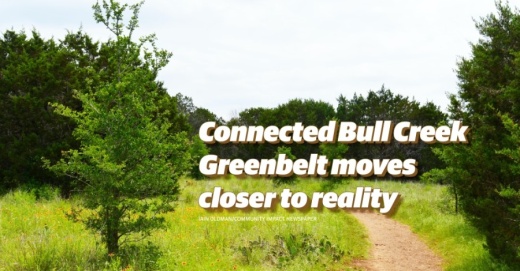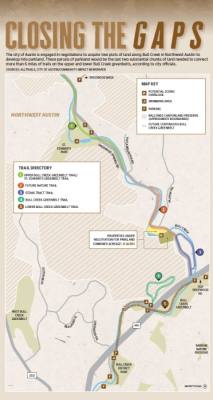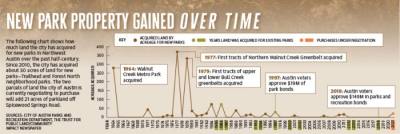Scott, the park development coordinator with the city of Austin’s Parks and Recreation Department, told Community Impact Newspaper that he has been eyeing the property as one of the last remaining puzzle pieces to finish a continuous Bull Creek Greenbelt.
“These are the last two pieces that we are pursuing,” Scott said. “I’ve been working on acquiring this property for 23 years.”
Austin City Council voted in late March to begin negotiations on this parcel of land near Spicewood Springs Road and Loop 360. According to council documents, the city will spend up to $3.51 million—funded through bond funds and parkland dedication developer fees—to purchase the land from the T.E. and Juanita H. Hough Living Trust.
The city plans to use this property, combined with an adjacent 11-acre plot of land currently under eminent domain proceedings, to build nature trails with creek access. These trails will help connect the existing trail systems between the 47-acre Bull Creek District Park and the 80-acre St. Edward’s Park to create one continuous Bull Creek greenbelt that runs through some of the unblemished nature preserves left in Northwest Austin’s pocket of Hill Country.
Though substantial delivery of these trails is years off, local parks advocates say this 7-mile stretch of trail network will add much needed access to green space for Austin residents.
“The pandemic has really highlighted peoples’ needs for safe outdoor spaces for recreation,” said Rachel McGill, president of the Bull Creek Foundation. “One of the jewels of the parks system is the Barton Creek Greenbelt, but it’s so heavily used. [The Bull Creek Greenbelt] would be a secondary jewel in the trail system for the city.”
ACCESS TO NATURE
Council voted March 22 to acquire the new parkland property. Scott said the city has long made it known it was interested in the land under the understanding it would be developed into parkland. Recently, the matriarch of the Hough family property passed away and the family trust reached out to sell the land to the city.
The property is located about a half-mile north of Loop 360 off Spicewood Springs Road. Scott said the land features accessible bluffs that could one day provide a scenic overlook out across the rolling hills of Northwest Austin.
“Seeps and springs—the property is littered with them. They’re all over. Everywhere you look there is a spring popping up. Wildlife just flourishes to that” Scott said.
About 1,900 linear square feet of Bull Creek run through the Hough trust property and an 11-acre plot of land currently under eminent domain proceedings, formerly known as the Spicewood Lodge property. That land is located directly northwest and neighbors the Hough trust property.
The two properties also directly neighbor the Balcones Canyonland Preserve, an urban nature and wildlife preserve that covers about 50 square miles of land across western Travis County. The BCP encompasses swaths of forested hills, dotted from Volente to Bee Cave to Emma Long Metropolitan Park, and was established in 1996 to protect the natural habitats of eight local endangered species.
McGill with the Bull Creek Foundation stated that direct contact with a nature preserve comes with a responsibility to be extra vigilant as stewards of the environment. On the eastern side of Spicewood Springs Road across from the Hough trust property, a plot of land called the Stenis Tract serves as a water quality site, according to McGill. The Stenis Tract is so environmentally sensitive that dogs are not allowed on the property, leashed or unleashed.
DEVELOPING THE PARKLAND
The trail that is designed to run through the two new sections of parkland will eventually connect to the Bull Creek Greenbelt, creating one long, continuous trail. The full trail will run about 7 miles and cross through hundreds of acres of parkland.
One section of trail between the Spicewood lodge property and St. Edward’s will need to be built in order to fully connect the greenbelt, but Scott said the property owners have already told the city it will be granted easements for the connection.
There is currently no hard and firm timeline for construction to start on the new nature trail along Bull Creek. Scott and Alison Alter, who represents Austin’s District 10 on City Council, said the city is still technically negotiating price for both pieces of property, and then the city has to begin its vision plan process. This will include design input from the community and other stakeholders.
One common design element that both the city and community agrees needs to be addressed is a lack of parking.
Richard Brimer, a director with the Yaupon Bluffs Homeowners Association, said overspilling parking has been an issue on Spicewood Springs Road for years. As more people access St. Edward’s and the lower Bull Creek Greenbelt, Brimer said the number of parking spaces at trailheads have failed to keep up with demand. There is currently one lot at St. Edward’s, as well as limited roadside parking. As a result, cars frequently park illegally on the side of the road on weekends.
“Generally speaking, it is a terrible situation. There are a lot of parking spaces and people use them, but there is not enough,” Brimer said.
Alter back in August 2020 told Community Impact Newspaper the Spicewood lodge property was “not being purchased with the idea of being a heavily developed park.” Because of the land’s proximity to the BCP, developing the park similar to a space like Zilker Park—with athletics facilities and large playgrounds—will likely prove unrealistic.
Brimer said that is consistent with Yaupon Bluff’s vision of that parkland, and the Bull Creek Foundation has similar sentiments.
“We support the idea of keeping it as a less developed park,” McGill said.
THE NEED FOR PARKS IN NORTHWEST AUSTIN
With the acquisition of the two new parcels of property, the city would add approximately 21 acres of parkland to the Northwest Austin area.
Alter said the city’s pools and swimming holes continue to be important for people in the city to cool down.
“We need more of those spaces. People need to be able to pause and get out into nature. And here in Austin, we need access to water,” Alter said.
According to data from the Austin Parks and Recreation Department, the city last acquired new parkland in Northwest Austin in 2018 when it added a new section of the Northern Walnut Creek Greenbelt.
“We’re not acquiring parkland at a clip that can keep up with demand, so what you’re seeing is a lot of parks are being heavily used” said Colin Wallis, CEO of the Austin Parks Foundation—a nonprofit organization established to support the development of parks and guarantee park access. The Trust for Public Land, a nationwide nonprofit whose mission is to create and protect parklands and other public spaces, each year publishes reports comparing parkland acreage and parks spending between cities across the U.S. The report found Austin in 2020 had 18.2 acres of parkland per 1,000 residents. That was above the median mark for other cities with comparable density, but still behind cities such as San Antonio, Phoenix and San Diego.
Austin in its 2019-20 fiscal year spent $140.29 per resident on operating and capital spending costs related to parks, according to the Trust for Public Land. That is nearly $30 more per resident than the previous year.
Voters in 2018 approved a $149 million bond that authorizes the Parks and Recreation Department to acquire land for parks. The two pieces of land in Northwest Austin currently under negotiation will be purchased partially through funds from that bond. About $2 million of the purchase of the Hough trust property is funded through parkland dedication, or fees that developers pay that fund park acquisitions.
“Parks are central to our quality of life here in Austin, and they help shape how we grow, how we gather and how we come together as a community,” Alter said.







